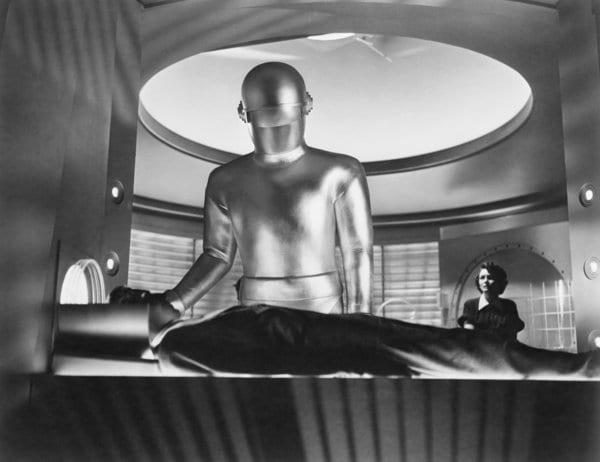
Guest post by Jessica Davis Tagg, Assistant Director of Events, Facilities, and Guest Services at IU Cinema.
The Day the Earth Stood Still stands as one of the earliest and greatest examples of film exploring the mystery and fear of alien contact, using it as an allegory for our mistrust of one another. With its flying saucer, all-powerful robot, and unnervingly calm humanoid alien, much of this movie feels surreal, and that unsettled feeling is encouraged by near-perfect music by Bernard Herrmann, underscoring its action.
Herrmann is best known for his work with Alfred Hitchcock (North by Northwest, Vertigo, Psycho, and many others), as well as his brilliant scoring in Citizen Kane, Taxi Driver, and for creating the season one theme for The Twilight Zone. What often gets lost in the shuffle is that Herrmann’s true genius lay in his orchestration—what instruments he chose to accompany the stories he was sonically illustrating.
Orchestration is the sine qua non of film music—imagine Darth Vader appearing onscreen to “The Imperial March” played by a flute choir. The musical notes are the same, but the feeling is completely different. Most film composers past and present rely on a standard symphony orchestra, with strings, woodwinds, percussion, and brass. There are a myriad of reasons for this, including the fact that the symphony orchestra contains the potential for a host of musical colors, as well as the fact that a symphony orchestra is much easier to find, hire, and record than, say, 17 individual piano players.

But Herrmann refused to be limited by one ensemble. He could write brilliant music for a symphony orchestra (The Devil and Daniel Webster, for instance, which won him his second Academy Award), but instead of sticking to that script, as it were, he was always looking for other options. For Beneath the 12-Mile Reef, he used 9 harps to get an ethereal, under-the-sea sound. For Psycho, he used only stringed instruments for “a black-and-white sound,” as he put it. For Journey to the Center of the Earth, he eliminated strings entirely, adding five organs and the serpent, a 16th-century era precursor of the tuba.
For The Day the Earth Stood Still, Herrmann accumulated a most peculiar ensemble: three electric string instruments (violin, cello, and bass), two Hammond organs, an electric organ, two pianos, one celesta, two harps, three vibraphones, two glockenspiels, percussion, one horn, three trumpets, three trombones, and four tubas. To this he added the distinct sound of not one, but two theremins.*

Who could have dreamed up such an ensemble? But The Day the Earth Stood Still with another set of musical sounds is nearly unthinkable. While the theremin had been included in a handful of early film scores (Shostakovich used it in his score to the film Odna, as well as Miklós Rózsa in Spellbound), this is still an exceptionally early use of electronic music (the theremins in particular, as well as the electronic string instruments) as more than a novelty.
*If you do not recognize the name of the theremin, you will certainly recognize its distinctive sound as the (woooo-OOOOOOOO!!!!!) creepy music that plays whenever you see aliens or other such unsettling science-fiction-y concepts. I could write an entire entry on just the theremin’s history, or its use in science fiction, but there are a wealth of materials to explore on the Internet:
- This Google doodle gives you some background history, as well as a way to play with a simple digital theremin
- Once you play with the Google doodle, you can see Clara Rockmore play “The Swan” herself here
- A great alternate view of playing the theremin can be seen here during a performance of “Somewhere Over the Rainbow”
- Here is an example of the theremin with an orchestra
The Day the Earth Stood Still will be shown at the IU Cinema on February 3 as part of the First Contact series and the Science on Screen initiative.
Many films that Herrmann scored have been screened at the Cinema. In 2011, the composer was celebrated with the series Sound and Vision, which focused on his work with Alfred Hitchcock and Orson Welles. Films included Vertigo, Psycho, North by Northwest, Citizen Kane, The Magnificent Ambersons, and more.
In 2015, Citizen Kane and The Magnificent Ambersons were also a part of Orson Welles: A Centennial Celebration and Symposium.
Vertigo also made a repeat performance at the Cinema during the 2016 Themester: Beauty series.
 Jessica Davis Tagg, the Cinema’s Assistant Director of Events, Facilities, and Guest Services, has over a decade of arts administration experience working with groups such as the Interlochen Center for the Arts, Tanglewood Festival, and most recently served as the executive director of the Tuscaloosa Symphony Orchestra. Jessica continues to focus on developing and implementing ways to help people gain a deeper understanding and enjoyment of the arts.
Jessica Davis Tagg, the Cinema’s Assistant Director of Events, Facilities, and Guest Services, has over a decade of arts administration experience working with groups such as the Interlochen Center for the Arts, Tanglewood Festival, and most recently served as the executive director of the Tuscaloosa Symphony Orchestra. Jessica continues to focus on developing and implementing ways to help people gain a deeper understanding and enjoyment of the arts.


